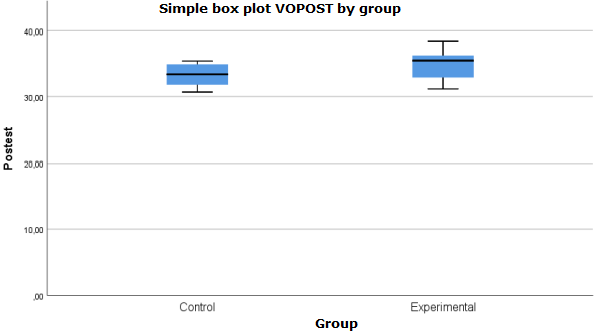Introduction
High-Intensity Circuit Training (HICT) has been proven to be one of the most efficient methods to improve physical and physiological parameters using short training sessions 1. Such exercise, more related to strength, can improve body composition, as well as cardiovascular, metabolic and functional fitness in physically inactive individuals 2.
These training sessions are characterized by short duration stimuli, between 15 seconds to 1 minute, of moderate to high intensity, and with pauses between 15 seconds to 2 minutes, with the performance of cyclical motor patterns such as running, jogging, etc.; or acyclic, such as strength exercises with external loads, such as elastic bands, dumbbells, discs, etc. 3.
Authors such as Yue et al. indicate that evidence has shown that High-Intensity Interval Training (HIIT) can be a superior alternative to Moderate-Intensity Continuous Training (MICT) to improve cardiovascular disease risk factors, such as the ability to cardiorespiratory and vascular function 4.
However, overweight and obesity are prevalent pathophysiological conditions in society, characterized by excessive adiposity and classified using BMI (WHO) 5. In Colombia, the Ministry of Health 6 revealed that one out of two Colombians is overweight, the rate is higher in women than in men. In the department of Huila, a prevalence of 55.3% is evident in adults aged 18 to 64 years.
An elevated body mass index is a risk factor for non-communicable diseases such as heart disease and strokes that were the main cause of death in 2012, 44% of the global cases of diabetes, 23% of ischemic heart disease and 7-41% of certain cancers are also attributable to overweight and obesity 7.
Various authors state that HIIT is effective in reducing fat in overweight or obese individuals12 and counteracting the effects of cardiometabolic diseases 8,9.
Thus, HICT generates changes in body composition, mainly fat mass. This morphological change is one of the factors most related to health since it is associated with a lower fat mass with reduced risk of mortality and comorbidity 1.
Therefore, this work aimed to identify the effects of HICT vs Interval Training on body composition and oxygen consumption in college students.
Materials and methods
Participants
Quasi-experimental study. The population is made up of 106 students aged 18 to 24 years, who attended the gymnasium of the María Cano University Foundation (FUMC) in Neiva during the first period of the year 2019. A probability sampling principle was used to select 30 students who attend the gym of the María Cano University Foundation and who met the following inclusion criteria: be active students, attend the FUMC gym between February and May 2019, sign an informed consent and have a Body Mass Index (BMI) greater than 25 kg/m2 (overweight).
The members of the sample were randomly assigned to two groups of 15 students each: a control group of 15 students who carried out continuous training, and an experimental group of 15 students who carried out HighIntensity Intermittent Training (HIIT). At the beginning, each student voluntarily signed the informed consent to verify their willingness to participate in the research. Subsequently, each of the research participants were made aware of the purpose, benefits, and risks of the research.
Afterwards, each participant took the pretest that measured anthropometric variables. Then, the participants attended 20 training sessions, three times a week, with an average duration of 50 minutes. At the end of the total number of sessions, the posttest was administered to identify changes in the variables (Table 1).
Table 1 Timeline.
| Timeline | |
| Recruitment | First month |
| Assessment (pretest) | Second month |
| Intervention | Third and fourth month. Seven weeks (20 training sessions distributed three times a week) |
| Assessment (posttest) | Fifth month |
Source: Own elaboration.
Finally, this research was endorsed by the institution’s ethics committee, which considered it to be “Minimal Risk” according to resolution 008430 and the Declaration of Helsinki.
Instruments and procedures
A data gathering format, which included variables that allowed obtaining information according to the objectives, was designed. Those variables are:
Body Weight (PC) (kg): measurements were made using a SECA 803 electronic floor scale, with a 150kg capacity.
Size (m): measurements were made using a SECA 213 stadiometer, with a sensitivity of 1mm and a measurement range of 20 to 205 cm.
Body mass index (BMI): measurements were made using the formula PC (kg) / height (m2).
Percentage Body fat: measurements were made through a Trimcal 4000 Slim brand adipometer to determine the size of skin folds of the triceps, subscapular, pectoral, supra iliac, abdominal, anterior thigh and medial leg. The equation used was the one proposed by Yuhasz 10:
Men = sum of skin folds * 0.097 + 3.64 Women = sum of skin folds* 0.224 - 2.8
Lean muscle mass (LMM): measurements were made with an extendable millimeter tape measure to determine the following muscle perimeters: arm, abdomen, hip, upper thigh, and calf. To identify the values, the following Poortmanss 11 formula, which is applicable for ages 7-24 years, was used.
LMM (kg) = Height * [(0.0064 * CAG 2) + (0.0032 * CTG:2) + (0.0015 * CCG: 2)] + (2.56 * Sex) + (0.136 * Age)
CAG: corrected arm girth = relaxed arm girth - (Pl Triceps / 10); CTG: Corrected thigh girth = Middle thigh girth - (Pl Anterior Thigh / 10); CCG: Corrected calf girth = Leg girth - (Pl Leg M / 10).
Bone mass: measurements were made to determine the following diameters: radioulnar and biepicondillary femoral. Small diameters were measured with a small Campbell 10 pachymeter, 19cm aperture, 1mm precision, and large diameters were measured with a Smartmet brand anthropometer, measuring curves, 550mm aperture, and 1mm precision.
The formula used was the one proposed by Von Döbeln and modified by M. Rocha 10.
Kg bone tissue = 3.02 * ((height, m)2 * wrist diameter, cm * knee diameter, cm * 0.04)0.712
The diameters, perimeters and folds were evaluated only once in both the pretest and the posttest.
Oxygen Consumption (VO2): this variable was measured directly using a QUARK brand gas analyzer. with an inter-mill stress test which started with a 3-minute warm-up at a speed of 4 miles per hour and with an increase of 1 mile/hour every minute until the person is tired and with no increase in inclination angles.
Control Group Procedures
All training sessions were carried out in a treadmill, using a cyclical pattern that always started with a 10-minute warm-up at a speed of 6.5.
Subsequently, in the central phase of 30 minutes, intensity increases of two minutes were made at a speed of 8.5, followed by one minute with a speed of 13. These load increases were carried out 3 times during the central phase.
Finally, the return-to-calm phase lasted approximately 10 minutes with a speed of 5 and ended with static stretches of 30 seconds of the upper and lower extremities.
The intensity during the central phase of training ranges from 65% (speed 8.5) to 90% (speed 13) of each participant’s maximum heart rate. This variable was monitored using a Polar watch.
Experimental Group Procedures
The experimental group started each training session with a 10-minute warm-up either on a treadmill, bicycle, and / or jump rope.
In the central phase, 30-minute circuits were performed with high intensity and short duration. Two 15-minute circuits were done with 2-minute recovery interval between them.
Each circuit was made up of 5 to 6 exercises. Each participant performed as many repetitions as possible in the indicated time. These circuits had functional exercises such as burpees, semi-burps, loop jump, box jump, jog around the block, squat, jump squats, abdominal plank, abdominals in their different variations, raise and lower the box, jumping jack, skipping, etc. It ended with a 10-minute warm-up. For a total of 50 minutes.
The intensity during the core phase of training ranged from 75% to 100% of each participant’s maximum heart rate. This variable was monitored using a Polar watch (Table 2).
Data analysis
The data was entered into a matrix in Microsoft Excel and then exported to the statistical program (SPSS) version 24, where frequencies of all the variables were generated for each of the groups.
The Shapiro-Wilk test was administered in order to identify if the variables had a normal distribution. For the comparison of the quantitative parametric variables between the two groups, the student’s t-test was used and, in the case of comparison of non-parametric variables, the Wilcoxon test was used with a level of statistical significance of p<0.05.
Results
Table 3 shows that the control group had a significant decrease in body weight and BMI after the 20 training sessions, unlike the subjects in the experimental group who did not have significant changes in this variable, probably due to the marked increase in percentage of muscle mass. In relation to the percentage of body fat tissue, a statistically significant decrease in the posttest measurements is evident in the individuals of both groups (See Table 3, Figure 1).
Table 3 Descriptive Statistics and Comparison of Means of Anthropometric Variables in the Control and Experimental Group in Pretest and Posttest.
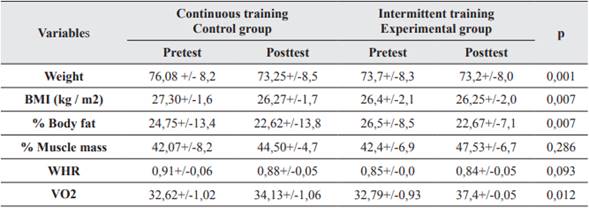
BMI: Body Mass Index / WHR: Waist-Hip Ratio / VO2: Oxygen Consumption.
Source: Compiled by the authors. Neiva-Huila.
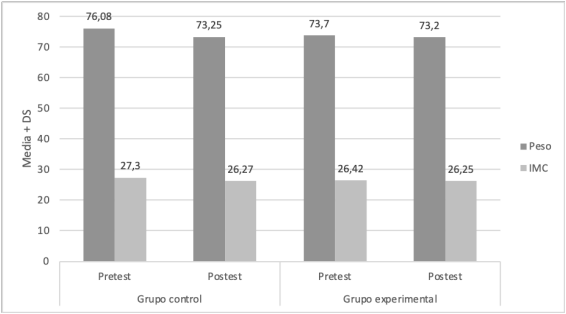
Source: Compiled by the authors. Neiva-Huila.
Figure 1 Weight and BMI after 20 intervention sessions.
The median and interquartile ranges show better results in VO2 of the experimental group and less variability with respect to the control group in the pretest and posttest. (Figures 2, 3 and 4).
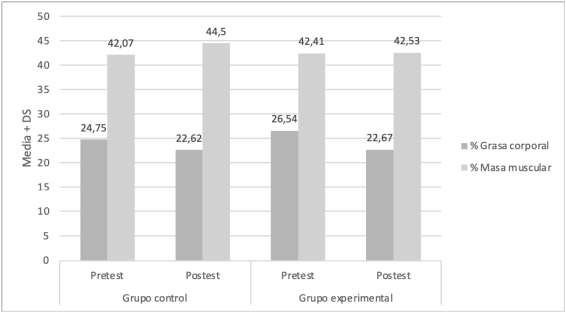
Source: Compiled by the authors. Neiva-Huila.
Figure 2 Percentage of body fat and percentage of muscle mass after 20 intervention sessions.
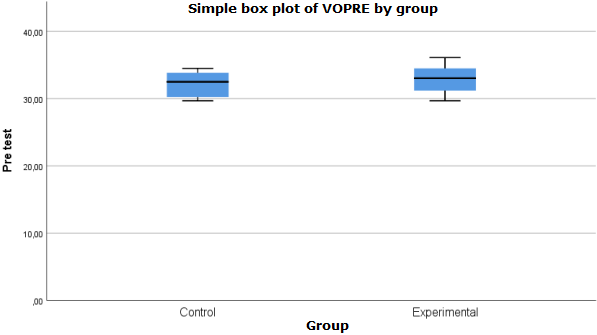
Source: Compiled by the authors. Neiva-Huila.
Figure 3 Distribution of VO2 max in the control and experimental group, before the intervention.
Discussion
Regarding the anthropometric variables, it was evident that Interval Training significantly reduces body weight as opposed to Intermittent Training. The data resemble the findings by Molina 12, who did not find significant changes in body weight, which he associates with an increase in muscle mass.
Authors like Pattyn et al 13, indicate that HIIT on a treadmill showed greater improvements in aerobic capacity compared to the cycle ergometer.
Likewise, it was found that the percentage of body fat showed a significant decrease with HICT, data that resembles the results by Viñuela García 14, who reports that after 12 sessions of HIIT in healthy young people there is a decrease in total fat mass. Paoli et al 15 have demonstrated that a HICT is more effective to improve strength and body composition.
Also, a study carried out by Molina 12 indicates that after 12 sessions of HIIT, a significant decrease in body fat occurs in overweight and obese people. Additionally, a review by Abarzúa 3 states that body composition does not always improve with HIIT training; however, workouts of 10 weeks or more can obtain significant improvements in this variable.
A study conducted by Martinez-Rodríguez 1 indicates that a 6-week HICT program is an efficient method to improve maximum strength (1RM) as well as body composition in physically active adult males, whether the training sessions are done 2 or 3 days a week.
Other authors indicate that HICT is more effective in improving blood pressure, lipoproteins and triglycerides than endurance training alone or lower intensity circuit training 17.
Furthermore, Barbosa 16 reports that overweight individuals who exercise at intensities of 75-90% over the maximum heart rate, whether continuous or intermittent, have significant improvements in body composition.
Authors like Swain et al. suggest that the higher the exercise intensity, the greater the increase in aerobic fitness 17.
A meta-analysis carried out by Silva et al. reveals that HIIT has better results in the percentage of fat mass compared to MICT 18.
Regarding the variable oxygen consumption VO2 max, both high-intensity intermittent exercise and continuous training show significant improvement. These data show similarity with the results of authors such as Montealegre and Romaña 19, since they reveal that HIIT improves aerobic capacity through oxygen consumption, in adults with obesity.
A study that aimed to investigate the effects of HIIT and Circuit Training (CT) on cardiorespiratory fitness (CRF), in 39 apparently healthy participants, who were randomly assigned to two sessions of HIIT or CT weekly for 8 weeks. The authors found that HIIT led to greater improvements in CRF compared to CT 20.
For their part, authors such as Cofré 21, reveal that HIIT generates equal or greater cardiometabolic gains in the short term compared to continuous aerobic exercise. Likewise, authors such as Fernandez 22 indicate that both continuous training and HIIT improve the cardiovascular capacities of those who practice it.
A study conducted by Helgerud et al. 23 that aimed to compare the effects of aerobic endurance training at different intensities and with different methods matched for total work and frequency, unlike High-Aerobic Intensity Endurance Interval Training is significantly more effective than the same total work at either lactate threshold or at 70% HRmax, in improving V’O2max.
Limitations
Within the limitations of the study, the number of participants of the sample is highlighted, although it is important to mention the background of some similar studies that take samples of less than 40 people, for example, samples of 35 participants 24 16 participants 15, 32 participants 25, 24 participants 26, and 32 participants 27.
In relation to body composition evaluation techniques, bioimpedance scales or standardized tests can be used in future studies. Likewise, it is important to be able to establish individualized training protocols, applying the principle of individualization in such a way that it is possible to have more data about the heart rate (intensity) of each subject that participated in the research.













